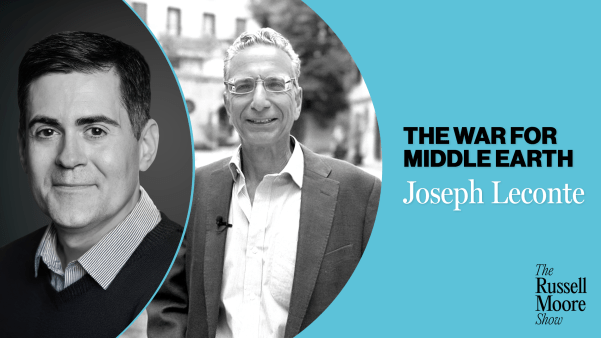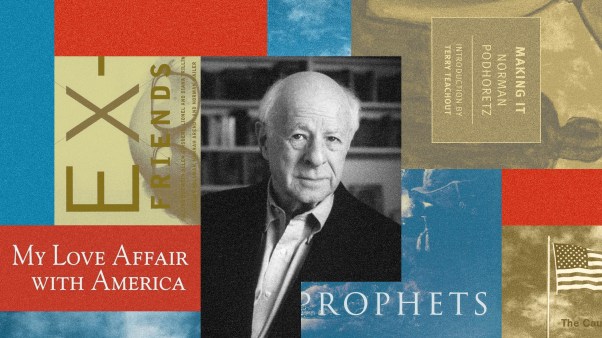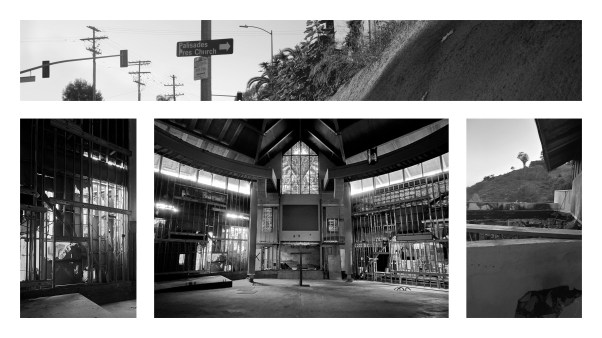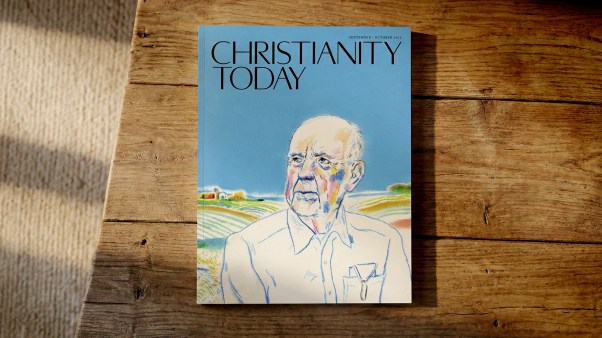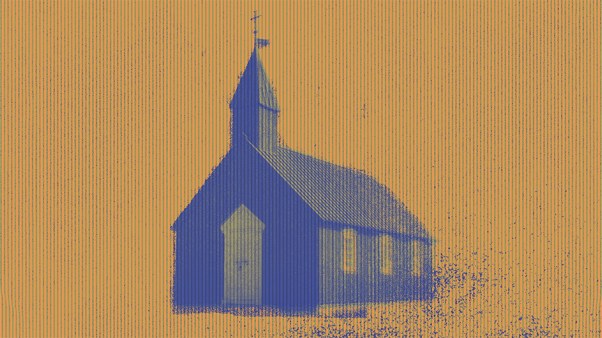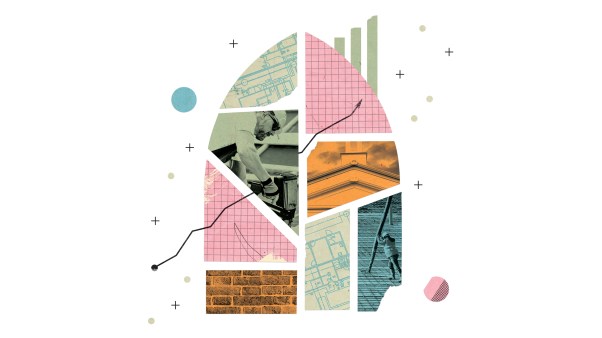When Sami DiPasquale visited conflict-torn Kurdistan for a research trip in 2009, he did not expect anyone there to know or care much about where he lived: El Paso, Texas. But when he told people where he was from, their eyes would widen.
El Paso! Wow! Isn’t it dangerous?
Aren’t things kind of crazy there?
He was barraged with similar questions about the southern US border in Egypt when he traveled there with a nonprofit in 2015. And in Thailand. And in Italy, which he visited in 2017 for his wedding anniversary.
Even in the United States, it was clear that people he met knew his town mostly as a symbol of chaos and violence at the nation’s border—despite the fact that El Paso consistently ranks as one of America’s safest major cities.
Over time, a wild idea took shape in DiPasquale’s imagination. What if El Paso could instead be sacred ground, a place where pilgrims came to seek the heart of God?
That idea is why, on a sunny March afternoon earlier this year, DiPasquale was leading a nine-person group from Christ Church Austin on a tour along the border wall. DiPasquale is the executive director of Abara, a nonprofit that seeks to build “connections beyond borders through mutual understanding, education, and meaningful action.” One way Abara does that is through Border Encounters, three-day educational immersion trips to the border.
That afternoon, the Border Encounter group shielded their eyes from the sun and walked beside the 30-foot-high steel slats dividing El Paso and Ciudad Juárez, Texas and Mexico. On a crunchy patch of dirt, the travelers came to a granite plaque commemorating El Paso pioneer Simeon Hart, who on that spot in the 1850s built his private residence, a once-luxurious adobe-style building that’s now one of El Paso’s oldest structures. It’s also where a vendor served the group beef tacos for lunch.
In 1992, Atlantic correspondent William Langewiesche visited El Paso and described the border as “grimy, hot, and hostile. In most places it is ugly… . The border is transient. The border is dangerous. The border is crass. The food is bad, the prices are high, and there are no good bookstores. It is not the place to visit on your next vacation.”
But here on a seared desert parcel jammed between the border fence and a busy overhead highway, DiPasquale likes to blow people’s minds with the rich history of El Paso. The bearded 47-year-old gestured at the Rio Grande to his right, which drought had shrunk to an emaciated trickle, then motioned ahead toward the bare mountains that bisect El Paso like giant sand dunes: “That’s where the river goes through.”
Centuries ago, the only way through the mountainous barrier was to ford the river in a spot where floods and natural currents had carved a rocky path shallow enough for horses and wagons to cross. That’s where they stood right now, DiPasquale said. “Literally for hundreds of years, from back to the Native American communities, this was the natural river crossing.”
Today, the Rio Grande—which flows from Colorado through New Mexico and Texas—serves as the part of the US-Mexico border that runs from El Paso to the Gulf of Mexico. Levees have tamed it, straitjacketing the streams in concrete collars. But once upon a time, the river ran free, wild, and providential. The waters fed the marshy plains of the otherwise arid land producing vineyards, fruit orchards, and wheat fields so vibrant that travelers 500 years ago called El Paso an “earthly paradise.”
 Photograph by Paul Ratje for Christianity Today
Photograph by Paul Ratje for Christianity Today Photograph by Paul Ratje for Christianity Today
Photograph by Paul Ratje for Christianity TodayThe river was also treacherous. There are written records of dehydrated travelers who, after days of walking through the Mexican desert, would dive headfirst into the river and drown in its powerful currents.
As the most feasible route from the Gulf of Mexico to what is today the Western United States, the ford was where history was forged. Indigenous communities, such as the Mansos and the Piros, built small grass pueblos and irrigation canals by the river, crossing back and forth to hunt and trade. In 1598, Spanish conquistador Juan de Oñate and his entourage of almost 500 people were led to this ford by some friendly Mansos, who found them wandering and weary, hemmed in by river and mountains.
Oñate named this pass “El Paso del Río del Norte,” which became part of the famed El Camino Real de Tierra Adentro, a 1,590-mile route between Mexico City and San Juan Pueblo, New Mexico. (Oñate would later form the first European settlements in the upper Rio Grande valley and tyrannize indigenous communities; he was so cruel even by contemporary standards that he was put on trial in Mexico City.) For almost 300 years, this pass served as the only wagon-accessible road into the Southwest, opening the gate for thousands of Spanish colonists, missionaries, and settlers to freely traverse into the region.
“Now of course, there’s only echoes of that, because we have all this infrastructure”—DiPasquale waved at some Border Patrol surveillance towers—“and the river has been turned into canals. And now, we have a fence.” He gazed up at the seemingly impenetrable steel slats.
This part of the talk is when DiPasquale gets really excited. Juárez and El Paso were one community until 1836, he explained—when colonists defeated Spanish troops in the Texas Revolution and declared independence from Mexico.
Then, in 1846, under the spirit of Manifest Destiny, the US waged war against Mexico and eventually seized what is now western Colorado, Nevada, California, Arizona, New Mexico, Utah, and Texas.
“This is sort of crazy,” said DiPasquale, his voice rising. “It’s like borrowing this Old Testament theology of God’s covenant with Israel. Fast-forward 2,000 years, and here arrives English-speaking European settlers who believe God has transplanted this blessing onto them and has given them the land from sea to shining sea. I mean, it’s sort of wild, right? It’s beautifully arrogant.”
Soon after the Mexican-American War, veteran Simeon Hart arrived in what was then a very sparsely populated El Paso. He squatted next to the river ford and built a flour mill, eventually becoming the wealthiest man in the frontier town. Historians believe Hart brought with him the only Black slaves on record in El Paso. During the Civil War, he helped finance the Confederacy by trading cotton for war goods in other countries.
Even after the Rio Grande became a national boundary, people seeking a new life continued to cross it. From the 1830s until Emancipation, enslaved Americans fled across the river into Mexico (which had outlawed slavery in 1829). In the late 1800s, Chinese workers helped the railroads connect El Paso to Los Angeles, turning El Paso into a boomtown and earning it a reputation as the “Chinese mecca of the Southwest.” The Chinese Exclusion Act curtailed Chinese immigration in 1882, but migrants continued arriving anyway. They hid in smuggling houses in Juárez and illegally crossed the border into El Paso, using what’s now known as the Chinese Underground Railroad and what may have involved actual secret tunnels. (The precursor of the US Border Patrol was formed in El Paso in 1904 to keep Chinese people out.)
Around the same time, Arabic-speaking immigrants began arriving in El Paso through Mexico. They were followed in the 1920s by Jewish immigrants from Eastern Europe, who also crossed the border illegally.
As DiPasquale told these stories, the Border Encounter group listened with mouths agape. One woman, a native Texan, said she never would have imagined West Texas to be a place of such diverse heritage: “When I think about this kind of overlap of cultures, race, languages, history, and trade, my mind goes to maybe the Mediterranean or the Silk Road.”
Many El Pasoans are also unaware of this history. DiPasquale collected these little-known stories during many sleepless nights. Often he lies in bed next to his wife, wide awake and digging into online archives on his iPhone, emailing himself articles and research, until Marianne complains that he’s disturbing her sleep.
The stories of people at the southern border continue to fascinate him. El Paso may be at the literal edge of the United States, but it represents something central to the American story. El Paso is a crossing. Over centuries it has been the scene of thousands of inflection points, of watershed moments for people on the very human search for survival, refuge, wealth, and family.
In a way, El Paso is a place we all visit in life, sooner or later.
Rivers are rich in symbolism. The word abara comes from the Hebrew and Arabic words for “cross over,” “river crossing,” or “ford.”
“Crossing over” is a dominant theme throughout the Bible. In the spiritual sense, Christians cross over from death to life, moving from sin to righteousness. And in the physical sense, many of the Bible’s protagonists were marked by physical relocation: Abraham was an immigrant; so were Jacob and Joseph and their descendants in Egypt. Jesus was a refugee. Christians in the New Testament are referred to as “sojourners” (1 Pet. 2:11, ESV). Old Testament laws repeatedly reminded the Israelites to be gracious, generous, and fair to immigrants because they too were once outsiders.
In hindsight, DiPasquale had been preparing for Abara his whole life. He was born and raised in Jordan, the only blond-haired, hazel-eyed boy in his local Jordanian school. He spoke English at home but Arabic on the streets and in church. His late teenage years were spent in Nicosia, Cyprus, known as the world’s last divided capital, where barbed wire and metal barrels segregate the Christian Orthodox Greek and the Muslim Turkish communities. DiPasquale estimates that a quarter of his classmates were Lebanese refugees who’d fled that nation’s civil war.
He was not intending to build his whole career on the frontlines of America’s migration crisis.
In 2004, DiPasquale followed his wife, Marianne, to her hometown of El Paso. He was a 28-year-old newlywed and figured they’d move back to the Middle East within two years. He waited tables at an old-school Italian restaurant in a building that had reportedly functioned as a Border Patrol outpost in the 1930s. He took a part-time job at a local nonprofit and eventually became its executive director. A decade passed.
Then came the 2016 presidential election. DiPasquale started receiving emails, texts, and phone calls from organizations and individuals—friends, friends of friends—asking him, What’s happening at the border, really? They were hearing different things on different news channels and didn’t know what to believe. Could they come down to El Paso and see for themselves?
At the time, a large share of arriving migrants were children and families from El Salvador, Honduras, Guatemala, and southern Mexico seeking asylum. So in 2018, DiPasquale toured those countries with a group from the Christian Community Development Association (CCDA) to understand what was driving people to flee. He met with pastors and community leaders and asked them, “What would you like to tell the American church?” Many replied, We’re not animals. We’re brothers and sisters in Christ, and our brothers and sisters are fleeing to your borders, seeking refuge.
“That was really hard, that they felt like they even needed to say that,” DiPasquale recalled. “All of a sudden, I just felt compelled. I was overwhelmed by this sense, drowning, almost … that I, Sami, need to do more about this work.”
 Photograph by Paul Ratje for Christianity Today
Photograph by Paul Ratje for Christianity TodayFor years, DiPasquale had been nursing a desire to pursue peace-building work, inspired by efforts he had seen in the Middle East and Africa. When DiPasquale was in Central America, he felt God was weaving all the loose threads from various points of his life into one seamless quilt: He lived in a border town but had a global perspective on displacement and migration. Through his nonprofit work, he had built long-term relationships with churches and leaders on both sides of the border. And now, American Christians wanted to come to El Paso and learn.
Border tours were not new. DiPasquale had helped mobilize several over the years, and he noticed a pattern: Evangelicals came eagerly, hearts throbbing with compassion. They nodded in agreement with Scripture verses about welcoming the sojourner and with PowerPoints about immigration reform. Then a presenter would step up and say something about “social justice” or “liberation theology,” and everything would screech to a halt.
“All of a sudden, it was like, ‘Oh, this is all about Catholic social teaching. This is just a liberal thing. It’s not relevant to my faith,’” DiPasquale said. Three or four phrases would derail the entire exercise. “What really troubled me was that that was almost the only barrier for them to action.”
That’s why DiPasquale likes taking Border Encounter groups to the old river crossing. There, he doesn’t focus on current events or political polarization. Instead he tells stories of Chinese migrants in the 1880s, of the once-vibrant Black Wall Street in the early 1900s, of El Pasoans who can trace their ancestry to Jewish refugees and Arabic-speaking migrants.
Human history recycles the same old themes, DiPasquale said. Who’s wanted and who isn’t? Who belongs and who doesn’t? “There’s something in getting a little bit of distance from the present day, where we can start self-reflecting on issues. We need a little historical distance, to see a little clearer looking back and go, ‘Whoa, I can’t believe that happened then.’ And then even, ‘Wait, you know, what are the ways I might be doing that right now?’”
DiPasquale had been eyeing the land where the ancient ford existed ever since he founded Abara in 2019. He remembers reading about Bethabara, literally “house of the ford,” a place on the banks of the Jordan River where tradition says the Israelites crossed with Joshua to the Promised Land and John the Baptist baptized Jesus. DiPasquale envisioned an Abara House by the Rio Grande—a place where people cross all kinds of barriers, a place where fellow peacemakers could connect with strangers, neighbors, cultures, and histories beside the river.
When he shared his vision with his wife, “she thought I was crazy,” DiPasquale said. He thought he might be, too. “What on earth are you trying to buy all the way down at the border fence? Especially because, you know, the border is so polarizing and you have people arriving with heightened emotions, some people very angry.”
It did seem far-fetched. For more than 15 years, the three properties DiPasquale wanted had been dusty and chaotic, surrounded by the noisy construction of a highway and the reconstruction of the border fence. Simeon Hart’s former residence had opened and closed under several owners as a Mexican restaurant—at one time popular with college students and rife with ghost stories—but eventually stood cobwebbed and vacant. Many people had tried to buy the property, only to have the deal fall through.
Then in March 2021, all three properties went on sale within a span of 10 days. Abara signed contracts on all of them. “That was sort of miraculous,” DiPasquale said. Abara didn’t have funds to purchase them outright. For one property, they had about three months to come up with the money. For another, they had just three weeks.
The next few months were a rush to procure loans from big donors—most were on Zoom during the pandemic. The owner of one of the properties pulled out, but Abara raised $1.15 million to purchase the other two. They encompass more than four acres and include the historic Hart residence.
 Photograph by Paul Ratje for Christianity Today
Photograph by Paul Ratje for Christianity TodayThis year, Abara started a $15 million capital campaign to repay borrowed funds and restore the properties. If all goes according to plan, Abara will boast space for conferences and training, apartments for guests, a chapel, and a prayer garden. It will offer a café that serves food and drinks from impoverished and conflict-torn regions, a marketplace selling items from Abara’s migrant microenterprise program, and a gallery exhibiting art and history depicting the complexities of the border.
What does border art look like? Over the past year and a half, DiPasquale has been collecting flimsy wire ladders left behind after migrants used them to climb the border wall. So far, he’s amassed more than 120 and is hoping someone can turn them into an art installation that Abara can showcase.
“You can really get caught in a rabbit hole thinking about it,” DiPasquale said. “Like, whose story does this represent? What was their name? Where did they come from? Where did they go? All of a sudden, it’s just human beings and not this huge, crazy issue. And you’re just trying to figure out what to do with all of it.”
People join Border Encounters for all kinds of reasons. The nine visiting in March from Christ Church Austin had nine different explanations.
“I’m just tired of being angry about the border,” said Faye Gorman, a 70-year-old retired nurse.
Christopher Johnson came to El Paso to “learn to love people on both sides of the issue.” The 56-year-old architect and native Texan’s in-laws, who he says exclusively follow Fox News and Truth Social, drive him crazy sometimes with their politics. When people gripe about the “illegals” storming in with drugs and stealing jobs, he clenches his jaw. “But honestly,” Johnson confessed, “I didn’t really even know there’s a problem at the border until”—he lowered his voice—“Trump.”
Andrew Hadd, a 54-year-old director at a global genetic testing and diagnostics company, said he joined Border Encounters because “what I know about the border is a pantry, but what I don’t know is an Amazon warehouse. And I was falling for sound bites, not people.”
About a month before the trip, Hadd said, he was listening to Verdict, a podcast with Sen. Ted Cruz, in which Cruz blasted the Biden administration for producing “the worst crisis of illegal immigration in the history of our country.” Cruz claimed it was all part of Biden’s agenda: “That’s not a bug, that’s a feature. They want more of it! He doesn’t intend to fix this; he doesn’t want to fix this. Instead, he wants full-on open borders.”
The riling words worked. The image of an uncontrolled border allowing millions of strangers through made Hadd’s heart race. That’s why he needs Border Encounters, Hadd said. “I want my prejudices and misconceptions about the border to be destroyed.”
Kevin Lee, a 33-year-old archaeology PhD student, said, “I wanted to start to make amends and work off some of the guilt I’ve been carrying.” Eight years ago, he got sucked into the r/The_Donald subreddit thread, a now-banned online community known for hosting conspiracy theories and hate speech. He enthusiastically voted for Trump and supported Trump’s immigration policies.
 Photograph by Paul Ratje for Christianity Today
Photograph by Paul Ratje for Christianity TodayAnd then January 6 happened. If the events of 2020 and early 2021—a global health crisis, racial tensions and riots, an attack on the US Capitol—pushed a lot of otherwise reasonable people off the rational cliff, they did the opposite for Lee. He sobered up, calling January 6 his “personal apocalypse.” He chopped far-right blogs from his diet. He started questioning why he had gotten obsessed with Trump in the first place, why he pinned so much hope on him, and what he’d gotten wrong. And if he was wrong on this, what else had he gotten wrong?
“I want to get past the sound bites that I’ve fallen prey to,” Lee said. “I want to shut the door to my past opposition to immigration, which was not thought through at all. I want to learn the stories of people who once were nothing but faceless categories.”
These are exactly the kind of people DiPasquale hopes to attract: people from various political, cultural, and geographical backgrounds who know they have much to learn and who are open to learning more. The point of Border Encounters isn’t to raise activists and reformers, DiPasquale said, but to invite people into a pilgrimage. At every introduction session, he warns that some people might disagree with certain presenters during the course—and that’s okay. “We’re not here to correct anybody or solve the situation. We’re here to absorb and learn and make our way through the murkiness.”
Border Encounters invite both Border Patrol agents and pro-immigration advocates to share their perspectives as guest speakers. That made Border Encounters “feel safe enough to try,” Hadd said. He had voted for Trump and was weary of shrill rebukes. But it didn’t sound like Abara was going to harangue or guilt-trip him into repentance for his voting record.
Hadd also felt convicted: He has a PhD in analytical chemistry. He’s a naturally curious, passionate guy who likes data and facts and people, so much so that when he first told his wife he was interested in going to the border, she half worried he might come back radicalized and uproot his family to El Paso.
But Hadd couldn’t shake the conviction that he needed to go. “If I’m going to be in the world, and we are looking at an unprecedented amount of human migration in the world, what does this mean? I really don’t know what’s going on here. But I should find out.”
On day two of their visit, the Austin group crossed the border from El Paso to Ciudad Juárez to visit a church shelter for migrants. They stopped for lunch at a small museum by mile marker 1, which signals the international boundary between Mexico and the US. A group of men loitered in the parking lot on the Mexican side—most likely coyotes waiting to guide migrants, an Abara staffer told the group. Above them loomed a privately funded border fence running about a mile up a mountain. The wall sprang up almost overnight in 2019, after a group led by Steve Bannon called We Build the Wall raised millions of crowdfunded dollars. (Bannon is currently on trial for allegedly pocketing some of that money.)
Border walls became Trump’s political brand, but previous presidents, including George W. Bush and Barack Obama, also built them. In fact, what Trump mostly did was raise parts of the preexisting fence from 18 feet to 30 feet, which didn’t quite keep people out but caused more injuries as people attempted to climb it.
 Photograph by Paul Ratje for Christianity Today
Photograph by Paul Ratje for Christianity Today Photograph by Paul Ratje for Christianity Today
Photograph by Paul Ratje for Christianity Today“People die,” Border Patrol agent Tessa Reyes told the Austin group that morning. “People break their femurs. Women get scared, and they’re pushed over.” It’s a conflicting issue for some border agents. Even if the fence doesn’t stop people, it is still a deterrent in moments when 1,700 border agents are trying to stop 4,000 migrants from crossing at once.
“It’s hard for us, because at the end of the day, we consider ourselves humanitarian arms,” Reyes said. But Reyes also implied in her remarks that a country isn’t a country without borders, and the scale of migration at the southern border demands better border enforcement.
This was surprising information for some in the Austin group who mostly listen to media sources that downplay the hard realities at the border.
Both “push” and “pull” factors affect migration. War or violence or famine push people out, but a perception of lax immigration enforcement can also pull people in. After Biden promised a more welcoming approach, the number of migrants caught at US borders catapulted to a record high of more than 2.7 million in 2022. Border Patrol agents were outnumbered and underresourced as they attempted to process the thousands turning themselves in and requesting asylum in a system that was already backlogged with asylum claims. Shelters in border states filled beyond capacity.
The Biden administration backpedaled. In hopes of discouraging would-be crossers, it tightened border policies to prohibit migrants from Venezuela, Cuba, Nicaragua, and Haiti from requesting asylum at the border. But the move drew sharp criticism from immigration activists who say it will hurt those who lawfully qualify for the US asylum program.
Even tough immigration policies can only be so effective. Trump’s “zero tolerance” border strategy—which was best known for forcibly separating children from their parents at the border and which many viewed as cruel—failed to stop hundreds of thousands of people from attempting to cross.
In Juárez, the Austin group spent about two hours with such people at a church shelter that has received hundreds of migrants from more than two dozen countries in recent years. The Texans ate candy, played Jenga, and tried to communicate through broken Spanish and hand gestures. One 15-year-old boy showed Lee pictures of his hometown on his cellphone. Hadd and a woman in the Border Encounter group, who asked not to be named, kicked off their shoes and played soccer against two young teenage boys from Central America. The boys won.
It was a brief lifting of the veil, an awkward bumping of cultures. Meeting the eyes of these children, exchanging smiles with them, reminded Lee of the hours he had once spent reading blog posts that fomented outrage about the border. “I didn’t directly harm anyone, but I certainly harmed myself,” he said. “I felt guilty toward God that I would misuse my time and deform myself by turning a serious and complicated problem into cheap emotional entertainment.”
Johnson, the architect, watched a pregnant woman sitting propped against her husband’s chest. Her T-shirt was folded up above her stomach, and the man gently rubbed the flesh of her swollen belly. That look on the husband’s face—one of so much pride and hope—moved Johnson.
Until this point, Johnson had felt mostly despair and lament after coming on the trip and hearing migrants’ stories. “The world seems like such an incredible mess,” he said. Why would God allow this cycle of suffering to continue? And how was it that this couple at the shelter, who came with practically nothing and faced incredible challenges ahead of them, seemed to exude so much hope? It didn’t make sense. Johnson had come to the border on an airplane and lost hope. Meanwhile, some had trekked thousands of miles to the border on foot because of hope.
The border is strange like that.
The last day of the Border Encounter, the Christ Church Austin group gathered at Abara’s office early and read the Beatitudes together with fresh eyes.
“Blessed are those who are persecuted,” Lee said. He was thinking of women fleeing violence in their hometowns.
“Blessed are those who hunger and thirst,” Johnson said. He was thinking of malnourished children.
“Blessed are the peacemakers,” said another woman. She was thinking of Abara.
The group prayed together. “Help us show winsomeness as we engage with others about this,” Johnson said.
“Help us become salt and light,” Hadd asked.
It was time to go home. They climbed into the van that would ferry them to the airport. Three days was not enough to fully grasp the complexities at the border, but it was enough to overwhelm a person.
Several weeks later, Hadd was at Nebraska’s Platte River with his family, watching another migration. About half a million sandhill cranes flocked to the cornfields by the river, fattening up on insects and discarded corn in preparation for one of nature’s most epic journeys, from the American South to breeding grounds in Canada and Alaska.
“It’s stunning,” he exclaimed. “The heavens declare the glory of the Lord.”
The glory of God was manifest at the border, too, though Hadd isn’t certain he’s gained the clarity he had hoped for. “I don’t know if I learned ‘the truth.’ But I did get to meet people”—like Viktor and José, the boys who crushed him in soccer at the church shelter in Juárez. Hadd sent the church a soccer ball and pump in their honor.
He then looked up how his own ancestors came to the United States. Some fled oppression in Russia in the late 1800s. Some left Cornwall, England, after the tin mines failed. Others left France and England in search of better economic opportunities in Canada and Michigan.
“All of these fourth- to fifth-generation-ago folks came to the USA for similar reasons that we are seeing today (albeit with much less violence and challenges),” Hadd wrote in an email. “So, per our trip and discussions, I am more supportive of a major change in policy and ways to ‘open’ the border.”
Lee, the archaeologist, was in Naples over the summer doing fieldwork and research. He is used to excavating the knickknacks of long-gone people and resurrecting history. In a way, that’s what Abara did for him: It resurrected the stories of people who suddenly matter to him.
He remembers feeling giddy when Trump first won the presidency. “Looking back after seven years, it kind of feels like the center of a cheese puff,” he said. “It’s all air. There’s no heft to it. It was a very vaporous hope.”
But the hope Lee carried after the border trip felt different: “This hope feels rooted and anchored in something actually substantial and real.” This hope points to “God’s heart for healing and reconciliation and restorative justice”—and if God could mold Lee’s heart to reflect his, he can do it for others.
Lee turned 33 this year. He plans to return to Abara House in 40 years. He will be 73 then, hopefully a grandfather with a bit more wisdom. What will the house of the ford look like then? “I can’t wait to see,” he said. “This is the model. This is part of how our country is going to move into the future for all of us.”
Sophia Lee is global staff writer for CT.















